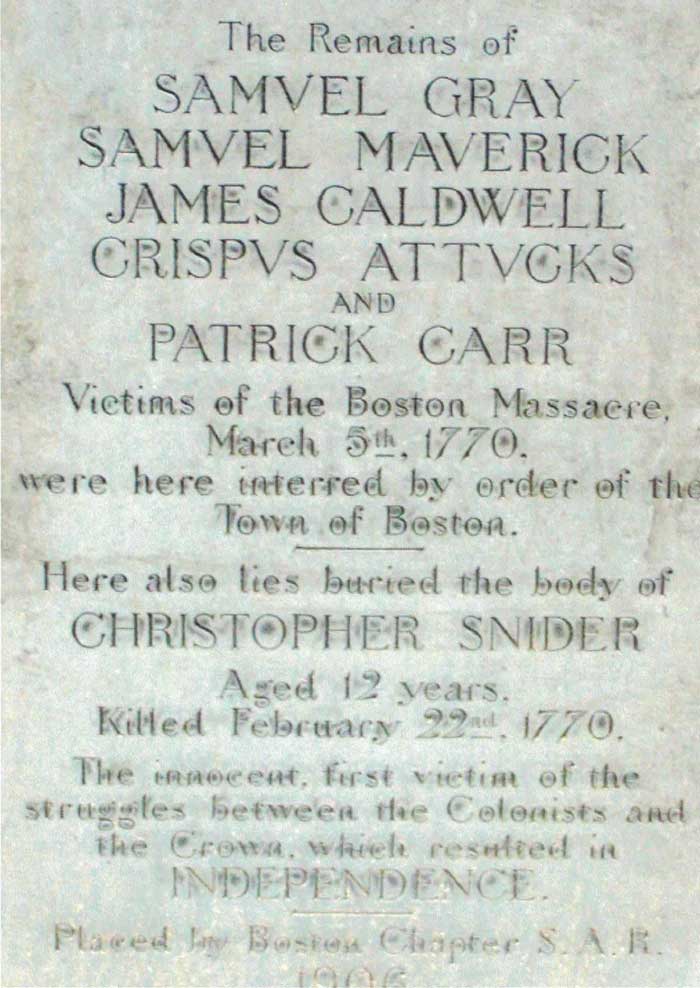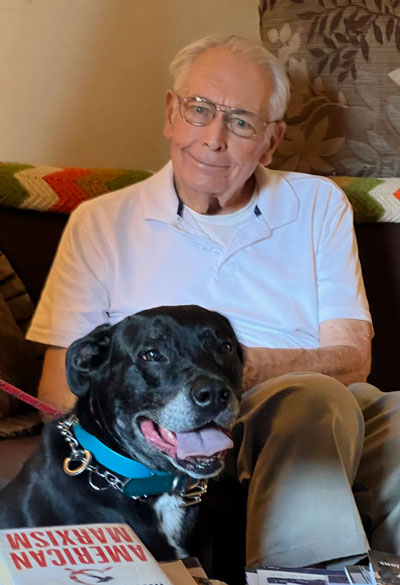
I’ve been to Boston, Massachusetts several times, and aside from the horrid traffic, I’ve thoroughly enjoyed each visit. Great food, especially at the Union Oyster House and Durgin Park restaurants, and lots of one of my favorite subjects: History. My wife and I have walked “The Freedom Trail” through Boston each time, and each of our “treks through history” has taken us to Old Granary Burial Ground, which is full of the graves of the famous (Paul Revere, John Hancock, Sam Adams, James Otis), and the not-so- famous of our early history. One grave marker in that ancient cemetery has always intrigued me, for carved on it are the names of five people whose deaths have been well documented by history. They are the five Bostonians who were killed by British soldiers at the infamous “Boston Massacre” on March 5, 1770, which occurred in front of the Old Statehouse Building. It is the 6th person that usually eluded my attention, the death of whom might have been THE catalyst that ignited our American Revolution.
(For my story, I’ve quoted freely from the following publications: Celebrate Boston, Find A Grave, Revolutionary War and Beyond, and “Christopher Seider” in Wikipedia. None of these publications had any author attributed to the articles, but I’ve used their research to amplify my own thoughts.) Most students of American history have been taught that our glorious American Revolution (the first one) began with “the first shot” on Lexington Green in Massachusetts on the early morning of April 19, 1775. Others are certain that it began with The Boston Tea Party on Dec. 16, 1773. Last October I made the case, here in The Times Examiner, that “The Gaspee Affair” of June 9, 1772 (when H.M.S. Gaspee, a British war ship, tried to capture a colonial merchant smuggling ship, the Hannah, in Narragansett Bay, later causing great indignation among the colonies), could be THE “cause celebre” that pushed the colonies finally to separate from Britain.
Of course, there were two much earlier “incidents” which happened in the hotbed of revolution, Boston, that some are convinced were of sufficient magnitude to stir up such political umbrage among our hot-headed revolutionary ancestors as to virtually assure an eventual break with our “Mother Country”, Great Britain. One was called “The Boston Massacre”, which occurred on March 5, 1770. That event surely did ignite the passions of Bostonians virtually to the breaking point, killing five “stirred up” patriots and wounding several others. Had it not been for the cool headedness of two of our eventual “Founding Father” attorneys, John Adams and Josiah Quincy, Jr., who represented the British soldiers who fired into the crowd (they were arrested, and after a trial most were found “not guilty”--two were found ‘guilty’ and had their hands branded), the “first shots” of the American Revolution might have started after that trial.
11-YEAR-OLD CHRISTOPHER SEIDER KILLED ON FEB. 22, 1770
However, it is the story of the 6th name on that Old Granary grave marker that recently piqued my curiosity, for I had virtually been oblivious to his existence until recently. Could it be an almost forgotten fact of American history that the death of an eleven-year-old boy at the hands of a frightened Boston Loyalist was the “spark” that was to eventually cause such a conflagration of indignation and rebellion among our revolutionary ancestors as to virtually assure the Glorious Revolution? I believe that it was not only possible, but probable, that the death of a pre-teen boy, who was caught up among the “rabble rousers” and angry hotheads in pre-Revolutionary Boston, DID ignite the first faint flash of resistance to tyranny that was to result in the defeat of the then mighty British Empire just thirteen years later.
The grave marker of Christopher Seider (his name-“Snider”-and his age-“I2”-were incorrect) proclaims him to be: “The innocent, first victim of the struggles between the Colonists and the Crown, which resulted in INDEPENDENCE.” So who was Christopher, and how did he lose his life in a mob on a crowded Boston street on Feb. 22, 1770, eleven days BEFORE the infamous Boston Massacre? Little is known of his life, and his story was almost lost to history and to the momentous events happening in the Colonies over the next decades . The boy was born to poor German immigrant parents sometime in 1758. At the time of his death at age ll (some new sources indicate he may have only been 10 when he was killed), he lived in the home of a wealthy widow named Grizzell Apthorp, and worked for her as her servant boy.
YEARS 1767-1770—A POWDERKEG OF PASSIONS
By 1770, all the British American colonies were engaged in boycotts of various goods produced in Britain, as a protest of the despised Townshend Acts, which taxed many common items, including tea, and greatly increased the penalties for refusing to pay customs duties. Always looking out to make profits, British Loyalist merchants usually ignored the boycott of British-imported goods imposed by their fellows and would use the scarcity of necessary goods by continuing to import them and sell them to other Loyalists, an endeavor which thoroughly incensed hordes of Bostonians. One such Loyalist was a man named Theophilus Lillie, who was the proprietor of a grocery store.
From the historical record, it appears that Mr. Lillie, a well known breaker of the boycott of British goods, endured a protest outside of his store on Feb. 22, 1770, as Bostonians tried their best to shame him and all of his customers over their support of the acts of a tyrannical parliament 3000 miles away. History students recall that at the end of The French and Indian War (1763), the British Parliament enacted a series of taxes that would force the colonies to pay for the large costs of protecting them and winning the war. We know that the colonialists considered these taxes to be unjust, and they became totally unpopular. In Massachusetts, and especially in and around Boston, resistance to these hated taxes took the form of frequent public protests and angry and unruly confrontations with tax collectors.
Making matters worse, in 1768 Governor Francis Bernard, fearing increased public unrest, requested the British government to send him 4,000 troops to keep order, mostly in and around Boston. Lacking sufficient barracks space for this large number of British troops, the Governor forced the colonists to provide quarters for them in their OWN HOMES, which infuriated the colonists. A new “resistance” group, which began calling itself The Sons of Liberty, was formed to oppose this attack on the colonists’ freedoms, adding more fuel to the incipient fires of rebellion.
It was into this powder keg of increasing mob hostility and very divided loyalties that Theophilus Lillie began to ignore the colonists’ demands to boycott British taxable goods, claiming he “would rather be ruled by a single tyrant than by a mob of tyrants”. Thus it was that on Feb. 22, 1770, a sizeable number of Bostonians gathered outside his shop to protest his lack of support for their boycott. The Loyalists had previously responded to these protests by demanding that the Governor station British troops throughout Boston to keep the peace and prevent damage. Often the colonists would throw snowballs, sticks, and even rocks at the soldiers, and sometimes engage them in fistfights. (These proto-Americans weren’t always ‘peaceful’, particularly in pre-Revolution days). Thus was the scene set for an event that probably influenced the course of American freedom.
Next time: The mob’s protest over lack of support for their boycott of British goods turns violent, causing the death of 11-year-old Christopher Seider, who is killed by a panicked Loyalist, and his funeral becomes a major rallying point in the incipient rebellion against the British Crown.














